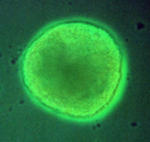Embryonic Stem Cells
Embyonic Stem Cells
Embryonic stem cells come from embryos which are vertebrates developing before birth. Embryonic stem cells are not derived from natural birth but in vitro birth which is birth given from a male's sperm and the female's eggs outside her body, in a laboratory test tube. Both animal and humans have these cells and human embryonic cells are derived from blastocysts which are contained in 4-5 day old embryos and are not visible without the aid of a microscope. Each blastocyst has about 50 to 150 cells each and is made up of three parts which are the trophoblast (the layer of cells surrounding the blastocyst), the blastocoel (hollow space in the blastocyst containing fluid), and the inner cell mass (a group of about 30 cells on the end of the blastocoel). Growing cells in a laboratory takes many steps but the whole process is known as cell culture. To get the embryonic cells to isolate, the cells packed together inside the blastocyst (known as the inner cell mass) are put onto a culture dish containing culture medium which is a broth that feeds the cells nutrients and helps them grow. The cells then spread out on the dish themselves having isolated. The culture dish's surface is also laminated with mouse embryonic skin cells to make the inner cell mass stick to culture dish. It is known as the feeder layer. The cells inner cell mass's cells then begin to grow and increase in quantity causing the culture dish to get crowded. The cells are divided onto fresh culture dishes and then after some time, put onto fresh dishes once again. This process is repeated for at least six months and is called subculturing. After approximately six months, the cells have multiplied and as a result, there are millions of stem cells concluding the experiment. Some of the cells have differentiated and are called pluripotent which have developed into different cell types of the body.
Embryonic and Adult stem cells are similar and different in many ways. Both types of stem cells were discovered over 20 years ago by extracting them from mice. They differ in the number and types of differentiated cells they can become. Embryonic stem cells can take any cell type of the body. Adult stem cells cannot do this but are thought to be able to generate or maintain different cells of different tissues.

